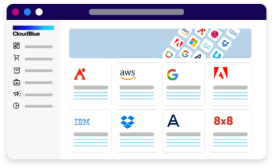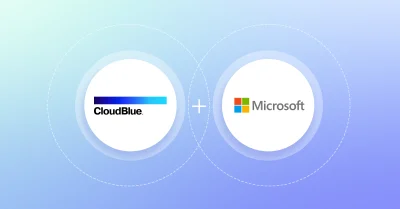Did you know that Gartner predicts IT service spending will expand by 7.9% in 2023 to $1.3 trillion? As IT departments battle staff shortages and tight budgets, knowledgeable providers who can build end-to-end technology service bundles will prove invaluable to business customers.
Any provider seeking to increase their share of the IT service market in 2023 will need to build broader product catalogs, sell integrated solutions and provide value-added guidance and support to their customers. With Everything-as-a-Service (XaaS) solutions the name of the game, all traditional industry segments have the potential to move into the MSP space, whether their existing business is distribution, vendor or provider. Success across the board will hinge on the ability to digitally transform, prioritizing customer experience and ease of purchasing as their guiding north star metrics.
Let’s take a closer look at the challenges aspiring service providers must overcome along with five central growth strategies.
The realities of service provision in 2023
With a looming recession, companies worldwide are actively seeking ways to make their business functions leaner and reduce operational costs. Digital transformation can help here, but doing this across all company processes isn’t straightforward. Negotiating with multiple vendors is complex and time-consuming, meaning decision-makers prefer to work with a single vendor with the ability to provide full IT services.
The IT supply chain is being forced to change as a result. We’re seeing channel segments form alliances to provide hardware, software, communication services and more as a one-stop-shop. For example, telecommunications provider Telefonica established a subsidiary called Telefonica Tech, and Orange recently acquired several cloud-based infrastructures and cybersecurity providers like Enovacom and SecureData.
Looking ahead, MSPs selling and integrating end-to-end business solutions will be ready to capture higher margins on software and services. The CloudBlue research team found that companies like Xerox (40%) and Cisco (70%) enjoy significantly higher margins selling XaaS business solutions than those selling mainly hardware, such as HP (19%) or Lenovo (17%). Selling services also demand less additional operational resources, meaning that MSPs won’t be limited when it comes time to scale.
While the potential lying within IT services seems clear, any MSP on the market will typically encounter at least one of these three growth-related challenges:
1. Fierce competition
The world of service provision is no longer limited to MSPs. For example, most IT vendors active in the XaaS market are now adding consulting, implementation, and management to their portfolio, making it more difficult and costly for MSPs to attract new customers. Providers will want to consider how they can sell more services per customer so that overall growth margins can increase.
2. Growing pains
When MSPs look to expand into new markets or increase the number of clients there are a number of operational challenges. For example, adding new customers often means there’s an increase in the number of employees, the complexity of service delivery, the complexity of billing, and the overall costs. Providers need to reinvent their traditional operations and develop a scalable business model.
3. High procurement costs
MSPs have the potential to penetrate vertical segments and increase revenue growth, but it will also depend on being able to find the right price point. With high procurement costs for IT coupled with tight budgets, a sensible pricing strategy that looks to build low-cost contracts by combining essential products with efficient IT infrastructures.
Five central growth factors
The good news is that none of the challenges we mentioned above are insurmountable. Let’s explore five ways MSPs can tap into new customer segments, increase efficiency and achieve long-term revenue growth.
1. Catalog expansion
First of all, MSPs need to increase their service offering by expanding their product catalog. Adding more solutions from different vendors can deepen existing segments or open the door to entirely new segments.
However, expanding a product catalog takes time and slows down progress as MSPs battle with vendor research, contract negotiations and multiple supply chains. You can solve this problem with CloudBlue’s off-the-shelf product catalog containing solutions from more than 200 leading vendors.
2. Automated XaaS delivery
With an expanded product catalog ready to reach new customer bases, automated service delivery is the next stage for MSPs. Without this, the task of managing customer orders and running billing cycles that combine products from multiple vendors becomes a mammoth task.
Yet if MSPs implement an automated procurement system that can manage every task, there’s no limit to scaling potential. Cloud procurement helps increase the efficiency of operations because all systems can use a single platform for unified procurement. In addition, the automation of cloud platforms can then be leveraged for catalog expansion, growth per customer, and new customer acquisition—all without increasing headcount.
Advania turned to CloudBlue to help automate up to 90% of its business. With its end-to-end procurement platform, Advania has grown its revenue from $100 million to $500 million and increased its headcount from 300 to 1,300.
Learn more about automated XaaS delivery.
3. Back-end procurement as a marketplace
As mentioned, MSPs can provide comprehensive IT management services to remove the burden for their customers. To enable seamless provisioning and management of IT services on behalf of clients, MSPs need a strong but simple-to-use procurement tool on the backend.
This means the internal staff benefit from a single view and automated processes for each contract in a single platform. The more complex the automation on this platform, the lower the total cost of ownership and the more efficient the ordering and fulfillment processes.
4. Empower the self-service buyer
While MSPs may have traditionally focused on enterprise customers with higher potential contract value, SMB clients worldwide also have a need for IT service provision. By implementing convenient self-service storefronts that connect to automated fulfillment pipelines, MSPs have the chance to tap into this new customer base while keeping operational costs low.
These marketplaces can target SMB customers with product packages that offer a pre-integrated range of solutions at a competitive price, easily available to buy online.
Learn more about launching a cloud marketplace with CloudBlue.
5. Deliver multi-cloud solutions
As demand for the cloud increases, so does the need to provide the most powerful yet cost-effective solution for each type of business. Hybrid cloud strategies can achieve just that.
If MSPs can offer centralized management across the private and public cloud they can uncover another attractive growth opportunity. Large enterprises have already moved mission-critical applications to public clouds such as Amazon Web Services, Microsoft Azure, and Google Cloud Platform while outsourcing non-core applications to private providers. Smaller companies are now looking to follow suit.
Discover CloudBlue’s integrations with public cloud vendors.
The digital future of service provision
As MSPs of all backgrounds look towards 2023, the many growth opportunities on offer are welcome news. To tap into new segments and sales methodologies with success, a digital-native mindset will be key.
Is your company digitally optimized? Reach out to a CloudBlue advisor today to learn how we can help you prepare at together@cloudblue.com.













